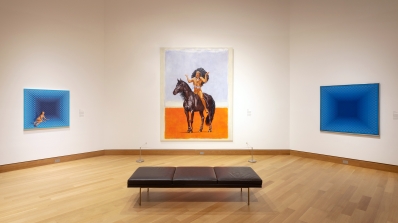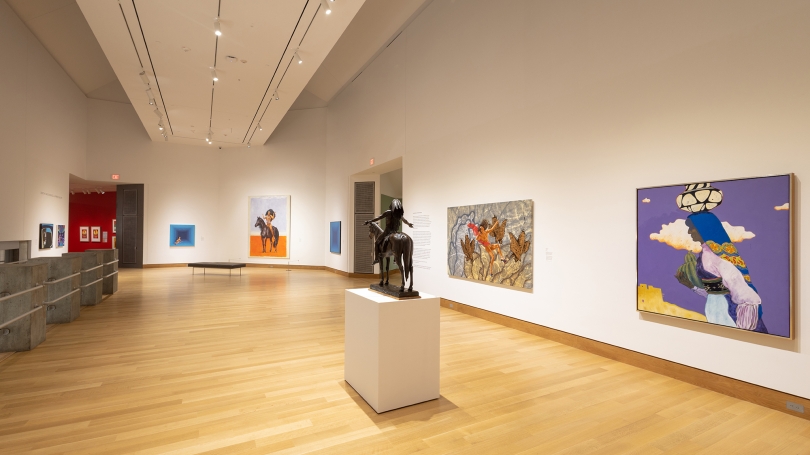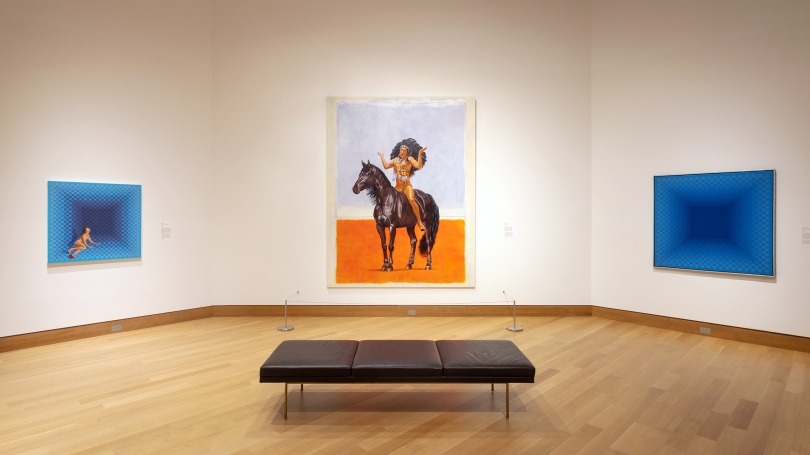Kent Monkman: The Great Mystery
JAMI POWELL, Associate Director of Curatorial Affairs and Curator of Indigenous Art
Hood Quarterly, spring 2023
When I interviewed for my position at the Hood Museum of Art, I was asked about what works I would like to acquire for the museum's permanent collection. One of the ideas I presented was a painting by Toronto-based Cree artist Kent Monkman, an item that still remains on my "wish list." Known for his provocative interventions into Western art history, Monkman explores the complexities of historic and contemporary Indigenous experiences across painting, film, performance, and installation. Monkman's gender-fluid alter ego, Miss Chief Eagle Testickle, often appears in his work as a time-traveling, shape-shifting, supernatural being who reverses the colonial gaze and challenges received notions of history.
In December 2019, a monumental commission of two paintings by Monkman, Welcoming the Newcomers and Resurgence of the People, opened in the Great Hall of the Metropolitan Museum of Art. In the accompanying catalogue, mistokôsiwak (Wooden Boat People), I wrote about how Monkman creates a shared and more nuanced history of the North American continent by recentering the narrative around an understanding and recognition of the contributions, generosity, and knowledges of Indigenous peoples. I also discussed how his works help us imagine a time and a place where and when Indigenous peoples and values provide leadership as we navigate through the crises impacting North Americans and global populations more broadly.
After viewing these works in person and having the opportunity to share them with my colleagues, we approached Monkman in 2020 to commission a large-scale painting based on the Hood Museum's permanent collection. Although Monkman was not able to visit our collection due to COVID-19 travel restrictions, our team sent several catalogues to Monkman's studio and shared numerous digital files with images and information about our holdings as well as information about the history of Dartmouth and its founding. Although I did not know the exact works that would inspire his process, I assumed he would be drawn to our historic collections and certainly the Orozco and Hovey murals since they have a narrative quality that aligns with Monkman's previous work.
Even though Monkman and I visited several times while he developed the proposal, I was not given a sneak peek of his prospectus because he wanted me to experience it for the first time along with my colleagues. When Monkman presented his plans to us, I was admittedly shocked. Monkman did not propose a single painting but several paintings, an entirely new body of work that represents a significant shift in his practice. The images inspired by the Hood Museum's collection were not history paintings at all but rather conversations with the modernist and abstract works by Mark Rothko, Hannes Beckmann, and Fritz Scholder, as well as a return to the style of the little-known Abstract Expressionist paintings Monkman himself created in the 1990s.
As Monkman was engaged with the commission for the Hood Museum, he was also finishing the Memoirs of Miss Chief Eagle Testickle, an autobiographical account of his alter ego's life. Drawing heavily on Cree language and ways of knowing, Monkman employs the concept of mamahtâwisiwin as the means by which Miss Chief travels through time and space to become an agent of disruption and change in Monkman's practice and historical narratives more broadly. Although there is no equivalent translation for mamahtâwisiwin within the English language, Monkman suggests that:
it can be described as a state of being in which one is tapped into the great mystery of the universe, of spiritual interconnectedness of all life, and of unknowingness.
Through his exploration of mamahtâwisiwin, Monkman returned to his early paintings as well as those of the abstract painters he'd studied. As he explains:
"In my formative explorations of the myriad possibilities of mark-making in paint, I was on a quest to describe the indescribable interconnectedness of living beings in the natural and spirit worlds. mamahtâwisiwin, as a philosophical Cree concept, was unfamiliar to me at the time . . . yet it was exactly this pursuit of the interconnectedness of life and spirit through abstract painting that led me instinctively to create several bodies of acrylic paintings that I am now revisiting. . . . Thirty years ago, I delved into the canon of Western abstract painting and abstract expressionism for inspiration, both technically and thematically. Now as I explore the concept of mamahtâwisiwin, the abstract paintings that inspired me take on new relevance and meaning."
This revelation led to the creation of Ghost Flower, a painting which Monkman originally created in 1997 and completed in 2022 by inpainting Miss Chief into a space representative of mamahtâwisiwin. For Monkman, the goal of his artistic practice has always been about the creation of pathways for multiple and shared understandings of histories across cultural divides. Therefore, he also revisited the works of Western abstract artists, like Lilac and Orange Over Ivory by Rothko, as another means of representing mamahtâwisiwin. In Monkman's painting, The Great Mystery, Miss Chief is placed on horseback—a playful challenge and reinterpretation of Cyrus Dallin's sculpture Appeal to the Great Spirit—in the center of the canvas. With her elbows bent and a quizzical expression on her face, Miss Chief contemplates the great mystery of the universe, but also the misunderstandings between Indigenous and Western value and knowledge systems. In Monkman's own words:
"In these new interventions with the work of abstract expressionists, similarities to the Indigenous worldview become apparent, but also the significant differences. . . . For hundreds of years settler cultures have lived in relationship with Indigenous peoples yet we remain mysterious to each other. . . . However, in folding the Cree concepts of mamahtâwisiwin into Western abstract paintings I am exploring the commonalities in our concepts of the unknowable."
Through his masterful technique, generosity, and humor, Monkman's paintings go beyond a simple retelling or restaging of art and its histories to create a shared intellectual space capable of encompassing multiple perspectives and interpretations. The commissioned paintings have disrupted my initial expectations and helped me to develop a greater appreciation and understanding of the abstract paintings in the Hood Museum's collections. I am excited to share The Great Mystery and Ghostflower with our audiences through this exhibition and for years to come.
Kent Monkman: The Great Mystery is organized by the Hood Museum of Art, Dartmouth, and generously supported by the Charles Gilman Family Endowment.


